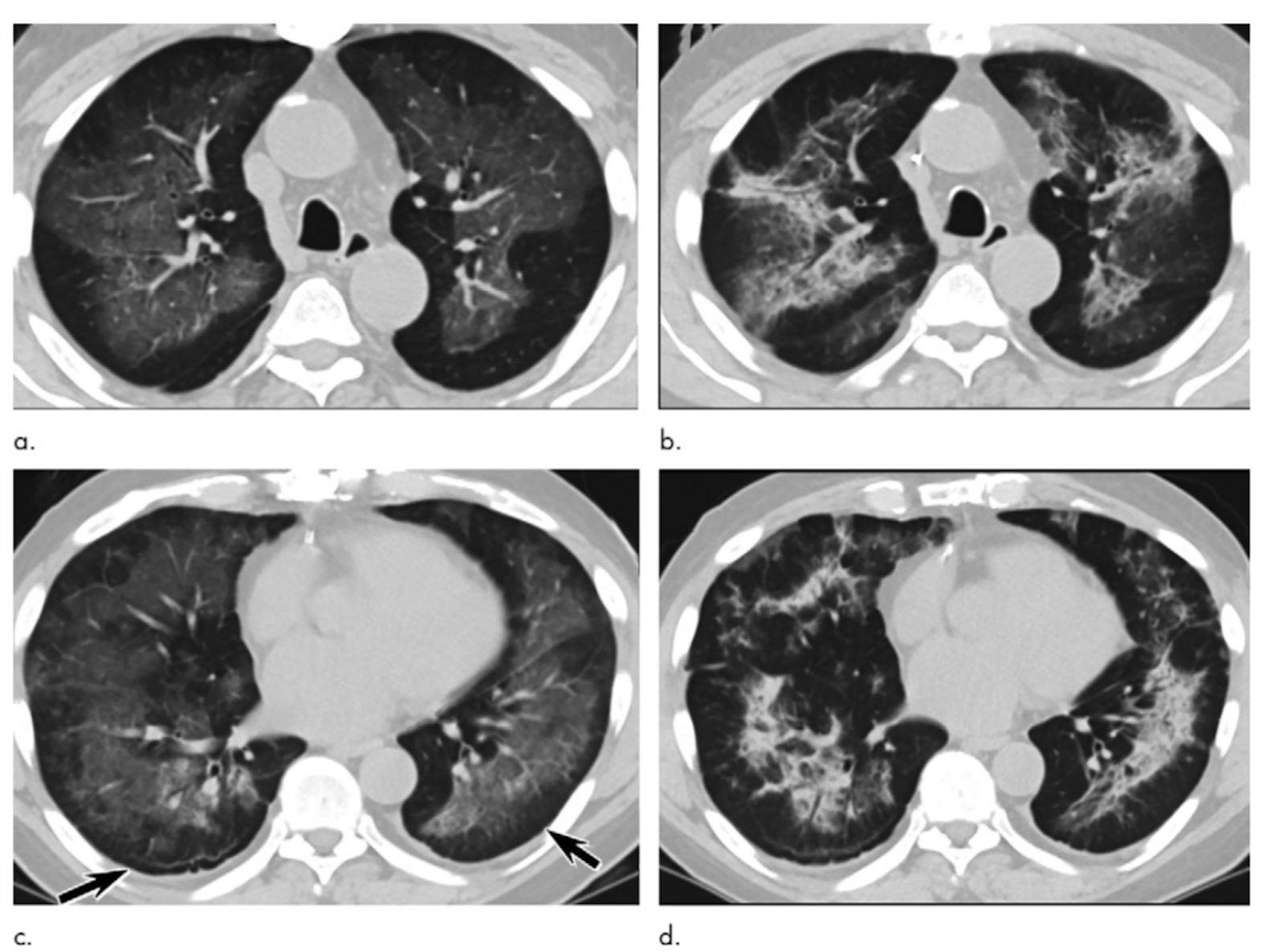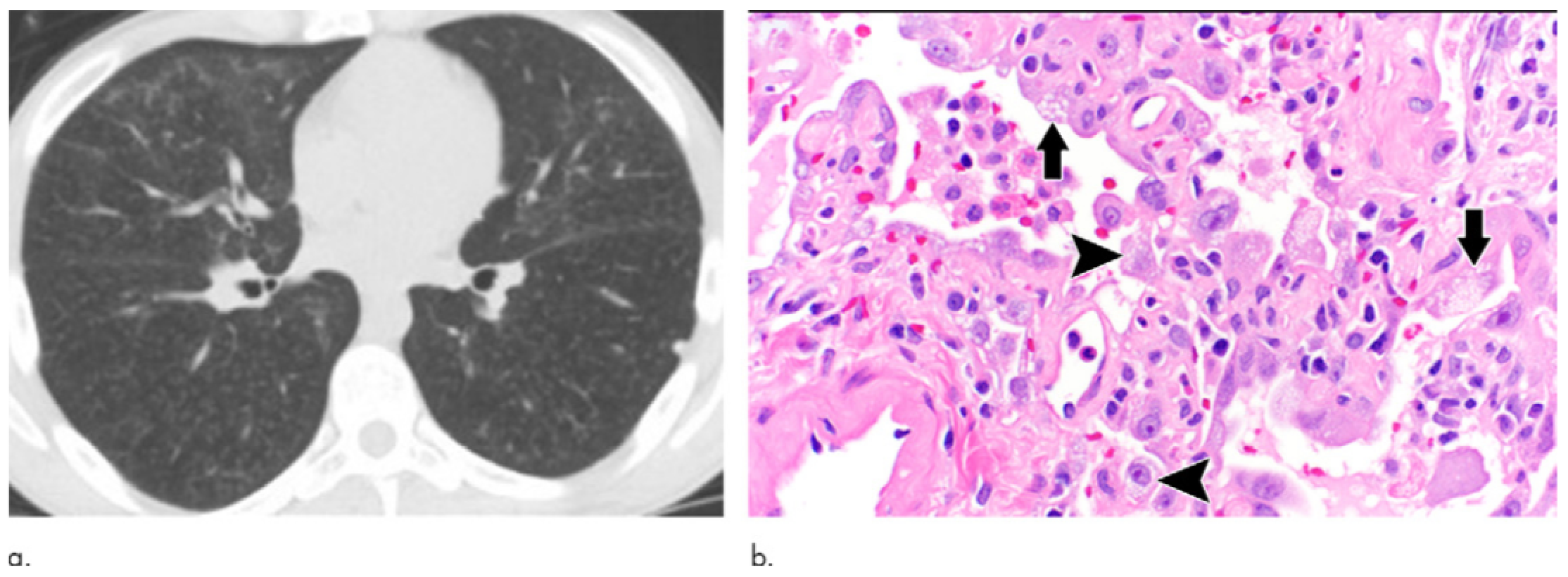CT Scans Show Vaping-Related Lung Injury Patterns
Identified patterns can be used to make more accurate diagnoses and, potentially, avoid unnecessary biopsies.
Lung injuries caused by vaping leave signature marks on CT scans, a follow-up study has revealed, arming radiologists with the details needed to potentially make more accurate diagnoses and help patients avoid unnecessary biopsies.
In a study published Aug. 27 in Radiology: Cardiothoracic Imaging, a team led by Michael Gotway, M.D., a radiologist at the Mayo Clinic in Arizona, laid out their findings that show these lung injuries – called EVALI (electronic cigarette or vaping product use-associated lung injury) – produce patterns on chest CT scans that correlate with previously observed pathological findings.
Electronic cigarette or vaping product use-associated lung injury in a 51-year-old man manifesting as an acute lung injury pattern at CT with subsequent organization. (a,c) Axial unenhanced CT images at presentation through (a) mid and (c) lower lungs show ground-glass opacity with subpleural sparing (arrows); this distribution was present in 45% of chest CT studies at presentation in our cohort (11). (b,d) Axial unenhanced CT images obtained 6 days later show ground-glass opacity has transitioned to consolidation and mild architectural distortion, consistent with developing organization. The patient was initially treated with antibiotics followed by corticosteroid therapy, with slow clinical improvement. Courtesy: Radiology

The first reports of EVALI surfaced last year from the Centers for Disease Control & Prevention. Within the first six months after this report, almost 3,000 EVALI-related hospitalization were recorded, as well as 68 confirmed deaths. Almost all patients present with complaints of shortness-of-breath, chest pain, and constitutional symptoms that can resemble viral illness. The non-specific nature of these symptoms can make an accurate diagnosis difficult.
Related Content: Chest Imaging Reveals Traits of Vaping-Related Lung Injuries in Teens
To determine how EVALI appears on CT scans, Gotway’s team conducted a study with 26 patients who met the EVALI criteria of e-cigarette or vaping use withing 90 days from symptoms onset, chest imaging abnormalities, and the exclusion of other potential injury sources, such as infections. These participants also underwent CT and biopsy or another type of tissue removal. From their examinations of the scans, the team discovered EVALI produces a common injury pattern: ground-glass opacity and consolidation.
Electronic cigarette or vaping product use-associated lung injury in a 21-year-old man manifesting as a nonfibrotic hypersensitivity pneumonitis pattern at CT that subsequently completely cleared. (a) Axial unenhanced CT image obtained 3 days after presentation shows diffuse, poorly defined centrilobular ground-glass opacity nodules; the CT pattern resembles nonfibrotic hypersensitivity pneumonitis. (b) Histopathologic findings show finely vacuolated foamy macrophages (arrowheads) as well as vacuolated type II pneumocystis (solid arrows) (Hemotoxylin-eosin stain, magnification, x60). Courtesy: Radiology

“We read the CT scan and, then, plugged it into one of those patterns and correlated that with histopathology,” Gotway said in a statement. “What we found out was that ground-glass opacity, sometimes with consolidation, is by far the most common pattern that we see with EVALI.”
Based on their findings, he said, 96 percent of patients exhibited multi-focal or diffuse ground-glass opacities and consolidation that involves most or all lobes bilaterally and could involve mild interlobular septal thickening and subpleural sparing. As the illness evolves, imaging findings can suggest mild architectural distortion, intralobular lines, lobular distortion, and traction bronchiectasis.
The second most common pattern, the team found, resembled subacute hypersensitivity pneumonitis. Thirty-two percent of patients presented with this pattern that appeared as ground-glass opacity centrilobular nodules or ground-glass opacity with mosaic perfusion, lobular low attenuation, or air trapping.
Other patterns were present in patients, but they were much less common. For example, an acute eosinophilic pneumonia-like pattern appeared in 12 percent of patients, as did an organizing pneumonia-like pattern. In addition 16.6 percent of patients experienced pneumothorax or pneumomediastinum.
Overall, Gotway said, these findings could be an arrow in the quiver of providers looking to determine a diagnosis for young patients with chest pain and shortness-of-breath.
“We hope to make radiologists aware that if they see diffuse lung opacities in a younger patients without clearly defined causes, then they may want to seriously consider that the patient could have a vaping injury,” he said.
Even though patients may be reticent to admit they are vaping, he said, if a radiologist recognizes one of these patterns on CT, he or she can advise the clinician, potentially leading to a nicotine metabolite test and further questions about exposure. Employing that approach could help patients avoid the invasiveness, time, expense, and risk associated with unnecessary biopsies.
“These radiological findings will be especially beneficial to physicians to help them determine potentially less invasive treatment options,” Gotway said. “We could potentially make that diagnosis non-invasively through cooperation with our clinical colleagues. By alerting them to a scan pattern that is suggestive of the possibility of EVALI, we may actually save patients from having to meet a surgeon.”
Meta-Analysis Shows Merits of AI with CTA Detection of Coronary Artery Stenosis and Calcified Plaque
April 16th 2025Artificial intelligence demonstrated higher AUC, sensitivity, and specificity than radiologists for detecting coronary artery stenosis > 50 percent on computed tomography angiography (CTA), according to a new 17-study meta-analysis.
The Reading Room: Racial and Ethnic Minorities, Cancer Screenings, and COVID-19
November 3rd 2020In this podcast episode, Dr. Shalom Kalnicki, from Montefiore and Albert Einstein College of Medicine, discusses the disparities minority patients face with cancer screenings and what can be done to increase access during the pandemic.
Could Lymph Node Distribution Patterns on CT Improve Staging for Colon Cancer?
April 11th 2025For patients with microsatellite instability-high colon cancer, distribution-based clinical lymph node staging (dCN) with computed tomography (CT) offered nearly double the accuracy rate of clinical lymph node staging in a recent study.
Meta-Analysis Shows Merits of AI with CTA Detection of Coronary Artery Stenosis and Calcified Plaque
April 16th 2025Artificial intelligence demonstrated higher AUC, sensitivity, and specificity than radiologists for detecting coronary artery stenosis > 50 percent on computed tomography angiography (CTA), according to a new 17-study meta-analysis.
The Reading Room: Racial and Ethnic Minorities, Cancer Screenings, and COVID-19
November 3rd 2020In this podcast episode, Dr. Shalom Kalnicki, from Montefiore and Albert Einstein College of Medicine, discusses the disparities minority patients face with cancer screenings and what can be done to increase access during the pandemic.
Could Lymph Node Distribution Patterns on CT Improve Staging for Colon Cancer?
April 11th 2025For patients with microsatellite instability-high colon cancer, distribution-based clinical lymph node staging (dCN) with computed tomography (CT) offered nearly double the accuracy rate of clinical lymph node staging in a recent study.
2 Commerce Drive
Cranbury, NJ 08512
All rights reserved.